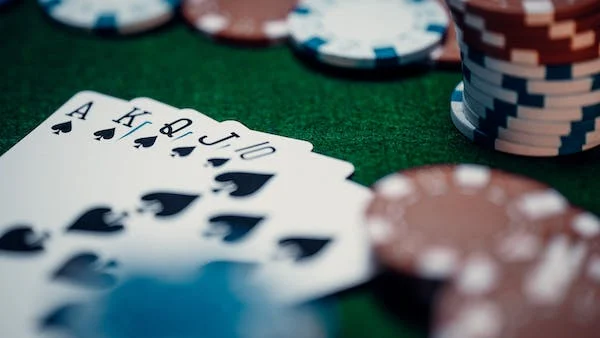“The Science of Poker Tournaments: An Analytical Approach to Winning Strategies” is a comprehensive exploration of the mathematical and strategic aspects of poker tournaments. This book delves into the intricate details of tournament dynamics, analyzing the game from a scientific perspective. By examining various mathematical models and applying statistical analysis, it offers readers a deeper understanding of the game and provides valuable insights into developing effective winning strategies. Whether you are a novice player or an experienced professional, this book serves as a valuable resource for enhancing your poker tournament skills and maximizing your chances of success.
The Role of Probability in Poker Tournaments
One of the key factors in poker tournaments is probability. Every decision a player makes is influenced by the likelihood of certain outcomes. Understanding the probabilities of different hands and the potential outcomes of each decision is crucial for making informed choices at the table.
At the most basic level, poker is a game of incomplete information. Players are dealt a certain number of cards, and they must use their knowledge of the game and their opponents’ behavior to make the best possible decisions. Probability comes into play when players are trying to determine the likelihood of their opponents having certain hands based on the cards that have been dealt and the actions they have taken.
For example, if a player is dealt two aces, they know that there are only three other aces left in the deck. This means that the probability of another player having an ace is relatively low. Armed with this information, the player can make more aggressive bets, knowing that their hand is likely to be stronger than their opponents’.
Probability also plays a role in determining the expected value of different actions. Expected value is a concept that measures the average outcome of a decision over the long run. In poker, players must weigh the potential gains against the potential losses of each decision to determine its expected value.
For instance, if a player has a flush draw on the turn, they can calculate the probability of hitting their desired card on the river. If the potential winnings from completing the flush outweigh the cost of the bet, the player can make a mathematically sound decision to continue with the hand.
Understanding probability is not just about calculating the odds of specific outcomes. It also involves understanding the concept of variance. Variance refers to the range of possible outcomes in a given situation. In poker, there is always an element of uncertainty, and players must be prepared for both positive and negative swings in their results.
By understanding the role of probability and variance in poker tournaments, players can develop winning strategies. They can make more informed decisions based on the likelihood of certain outcomes and the potential value of each action. This analytical approach allows players to minimize their losses and maximize their winnings over the long run.
In conclusion, the science of poker tournaments is a fascinating field that combines elements of mathematics, psychology, and strategy. Probability plays a crucial role in determining the best course of action in any given situation. By understanding the probabilities of different hands and the potential outcomes of each decision, players can develop winning strategies and increase their chances of success at the poker table. So, the next time you sit down to play a poker tournament, remember to consider the science behind the game and use it to your advantage.
Analyzing Player Behavior and Psychology in Poker Tournaments
One of the key aspects of analyzing player behavior in poker tournaments is understanding the concept of “tells.” Tells are subtle physical or verbal cues that players unknowingly give away, revealing the strength or weakness of their hand. These can include anything from a slight twitch of the eye to a change in breathing patterns. By carefully observing these tells, skilled players can gain valuable insights into their opponents’ hands and adjust their own strategies accordingly.
However, it is important to note that not all tells are created equal. Some players may intentionally give false tells to deceive their opponents, while others may have unconscious tells that are difficult to detect. This is where the science of poker comes into play. By analyzing large amounts of data and applying statistical models, researchers have been able to identify common patterns in player behavior and develop strategies to exploit them.
One such strategy is known as “range-based thinking.” Instead of focusing solely on the cards in their hand, players who employ range-based thinking consider the entire range of possible hands their opponents could have. By assigning probabilities to each possible hand, players can make more informed decisions and avoid falling into predictable patterns themselves.
Another important aspect of analyzing player behavior in poker tournaments is understanding the concept of “table image.” Table image refers to the perception that other players have of a particular player’s style of play. For example, a player who consistently makes aggressive bets may be perceived as a “loose cannon,” while a player who rarely bluffs may be seen as “tight.” By carefully managing their table image, players can manipulate their opponents’ decisions and gain an advantage.
Psychology also plays a crucial role in poker tournaments. Understanding the psychological factors that influence decision-making can give players a significant edge. For example, the concept of “tilt” refers to a state of emotional frustration or anger that can cloud a player’s judgment. Skilled players are able to recognize when their opponents are on tilt and exploit their emotional vulnerability.
Furthermore, the concept of “pot odds” is closely tied to player psychology. Pot odds refer to the ratio of the current size of the pot to the cost of a contemplated call. By calculating pot odds, players can determine whether a particular bet is mathematically favorable. However, players’ emotions and psychological biases can often cloud their judgment, causing them to make irrational decisions.
In conclusion, analyzing player behavior and psychology is a crucial aspect of winning strategies in poker tournaments. By carefully observing tells, employing range-based thinking, managing table image, and understanding psychological factors, players can gain a significant advantage over their opponents. While luck will always play a role in poker, it is the analytical approach to the game that separates the winners from the losers. So, the next time you sit down at a poker table, remember that the science of poker is not just about the cards – it’s about understanding the players.
Mathematical Models for Optimal Decision Making in Poker Tournaments
One of the key concepts in poker tournament strategy is expected value (EV). EV is a mathematical calculation that represents the average amount of money a player can expect to win or lose on a particular decision. By calculating the EV of different actions, players can make informed decisions that maximize their potential winnings and minimize their losses.
To calculate EV, players must consider several factors, including the probability of winning the hand, the size of the pot, and the cost of the bet. For example, if a player has a 50% chance of winning a $100 pot and the cost of the bet is $50, the EV of making the bet would be $25 ($100 x 0.5 – $50). If the EV is positive, it indicates that the decision is likely to be profitable in the long run.
Another important mathematical model in poker tournament strategy is the Independent Chip Model (ICM). The ICM takes into account the value of a player’s chips relative to their stack size and the prize pool. It helps players determine the optimal strategy for making decisions based on their chip stack and the potential payout.
The ICM is particularly useful in situations where players are nearing the bubble or the final table. In these situations, players must consider not only the value of their chips but also the potential increase in their payout if they make it to the next level. By using the ICM, players can make decisions that maximize their chances of reaching the final table and securing a larger payout.
In addition to EV and the ICM, players can also use game theory to inform their decision-making process. Game theory is a mathematical framework that analyzes the interactions between players in a game and seeks to find the optimal strategy for each player. In poker tournaments, game theory can help players determine the best course of action based on their opponents’ likely strategies.
For example, if a player knows that their opponent is likely to bluff frequently, they can adjust their strategy to exploit this weakness. By calling more often and bluffing less frequently, the player can take advantage of their opponent’s aggressive play style and increase their chances of winning.
In conclusion, mathematical models provide a scientific approach to poker tournament strategy. By calculating expected value, using the Independent Chip Model, and applying game theory, players can make informed decisions that maximize their chances of success. While luck will always play a role in poker, understanding the science behind the game can give players a competitive edge and increase their chances of coming out on top. So, the next time you sit down at a poker tournament, remember to bring your analytical skills to the table.
The Importance of Game Theory in Poker Tournament Strategy
Game theory, a branch of mathematics that deals with the study of strategic decision-making, has found its way into various fields, including economics, politics, and now, poker. In a poker tournament, where players are constantly faced with decisions that can have a significant impact on their chances of winning, understanding the principles of game theory can be invaluable.
One of the key concepts in game theory is the idea of equilibrium. In poker, equilibrium refers to a state where a player’s strategy is optimal, given the strategies of their opponents. By analyzing the range of possible actions and outcomes, players can determine the best course of action in any given situation. This can help them make more informed decisions and ultimately increase their chances of success.
Another important aspect of game theory in poker tournament strategy is the concept of mixed strategies. A mixed strategy involves randomly choosing between different actions in order to keep opponents guessing. By introducing an element of unpredictability into their play, players can make it more difficult for their opponents to exploit their weaknesses. This can be particularly effective in tournament play, where players are constantly changing tables and facing new opponents.
In addition to equilibrium and mixed strategies, game theory also provides insights into the concept of bluffing. Bluffing is a fundamental part of poker, where players attempt to deceive their opponents into making incorrect decisions. By understanding the principles of game theory, players can determine the optimal frequency and size of their bluffs, based on the likelihood of their opponents calling or folding.
While game theory can provide valuable insights into poker tournament strategy, it is important to note that it is not a foolproof method for winning. Poker is a complex game that involves a combination of skill, strategy, and luck. Game theory can help players make more informed decisions, but it cannot guarantee success.
Furthermore, it is worth mentioning that game theory is not the only approach to poker tournament strategy. Many successful players rely on their instincts, experience, and observation skills to make decisions at the table. The science of game theory is just one tool in a player’s arsenal, and it is up to each individual to determine how best to incorporate it into their own strategy.
In conclusion, the science of game theory has become an increasingly important aspect of poker tournament strategy. By understanding the principles of equilibrium, mixed strategies, and bluffing, players can make more informed decisions and increase their chances of success. However, it is important to remember that poker is a complex game that involves a combination of skill, strategy, and luck. Game theory is just one tool in a player’s arsenal, and it is up to each individual to determine how best to incorporate it into their own strategy.
Statistical Analysis of Poker Tournament Data for Strategic Insights
Poker tournaments have long been a popular pastime for both casual players and professional gamblers. The allure of the game lies in its combination of skill, strategy, and luck. While many players rely on their instincts and experience to make decisions at the table, a growing number of players are turning to statistical analysis to gain a competitive edge.
Statistical analysis involves the collection and interpretation of data to uncover patterns and trends. In the context of poker tournaments, this means analyzing large sets of data to identify winning strategies and make informed decisions. By studying the outcomes of thousands of hands, players can gain valuable insights into the game and improve their chances of success.
One of the key areas of focus in statistical analysis of poker tournament data is hand selection. In any given tournament, players are dealt a wide range of starting hands, each with its own probability of winning. By analyzing data from past tournaments, players can determine which hands are most likely to lead to victory and adjust their strategy accordingly.
For example, statistical analysis may reveal that pocket aces (two aces as starting cards) have a high probability of winning. Armed with this knowledge, players can be more aggressive when they are dealt pocket aces, betting and raising to maximize their potential winnings. Conversely, they may choose to fold weaker hands that have a lower probability of success.
Another area of focus in statistical analysis is the concept of expected value. Expected value is a mathematical calculation that represents the average amount a player can expect to win or lose on a particular bet. By calculating the expected value of different betting decisions, players can make more informed choices and increase their overall profitability.
For example, suppose a player is faced with a decision to call or fold on the river (the final community card). By analyzing the pot size, the size of the bet, and the probability of winning, the player can calculate the expected value of calling. If the expected value is positive, it would be a profitable decision to call. If the expected value is negative, it would be more prudent to fold.
Statistical analysis can also provide insights into the behavior of opponents. By studying data on how different players bet and react in certain situations, players can gain a better understanding of their opponents’ strategies and adjust their own accordingly. This can be particularly useful in the later stages of a tournament when the remaining players are more skilled and experienced.
For example, statistical analysis may reveal that a particular player tends to bluff frequently when faced with a large bet. Armed with this knowledge, a player can exploit this tendency by making larger bets when they have a strong hand, forcing their opponent to fold and win the pot without a showdown.
In conclusion, statistical analysis of poker tournament data offers valuable insights into the game and can help players make more informed decisions. By analyzing hand selection, expected value, and opponent behavior, players can develop winning strategies and increase their chances of success. While poker will always involve an element of luck, a scientific approach can give players a competitive edge and improve their overall performance at the table. “The Science of Poker Tournaments: An Analytical Approach to Winning Strategies” provides valuable insights into the mathematical and strategic aspects of poker tournaments. The book explores various concepts such as game theory, probability, and decision-making, offering readers a comprehensive understanding of the game. By applying these analytical approaches, players can enhance their skills and develop winning strategies in poker tournaments.




